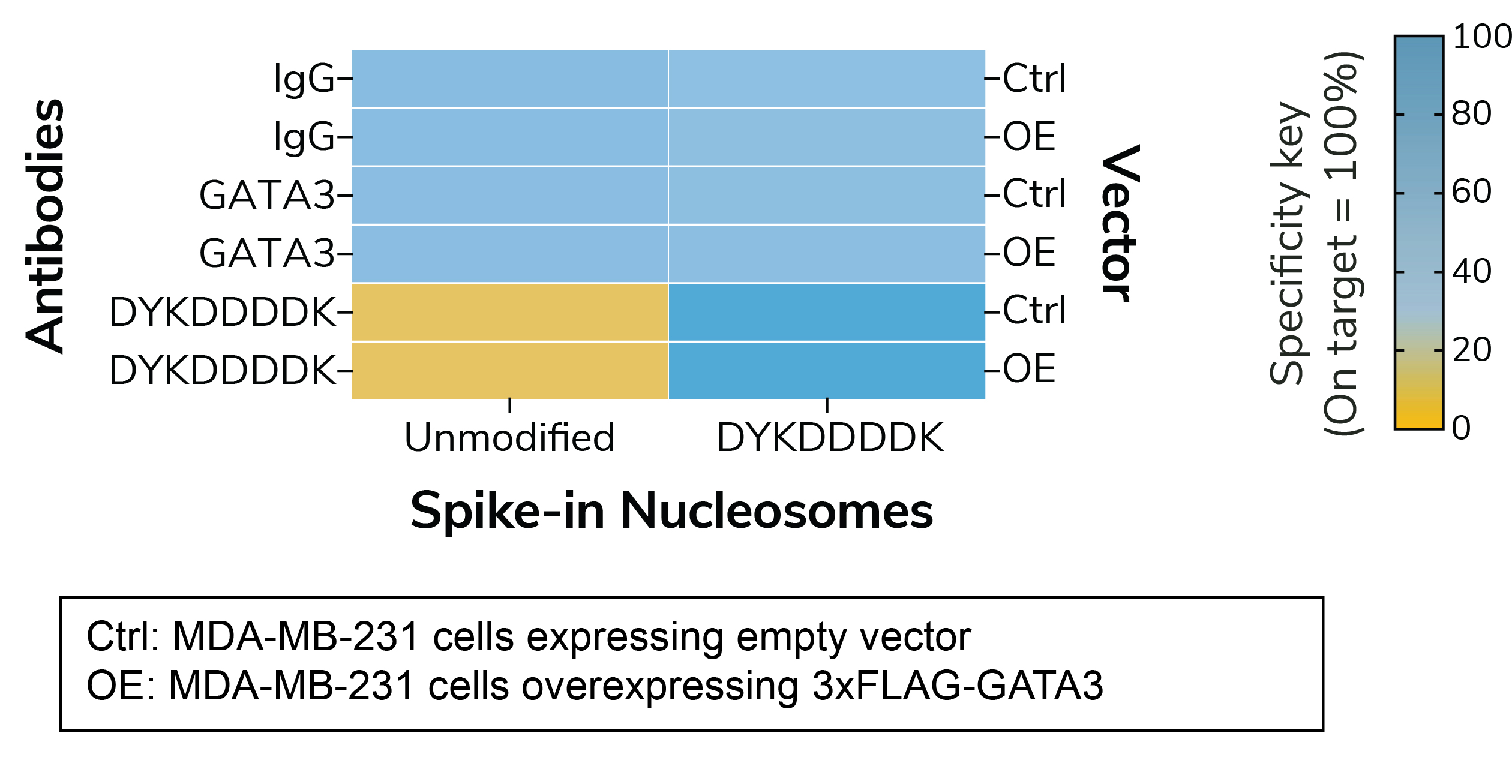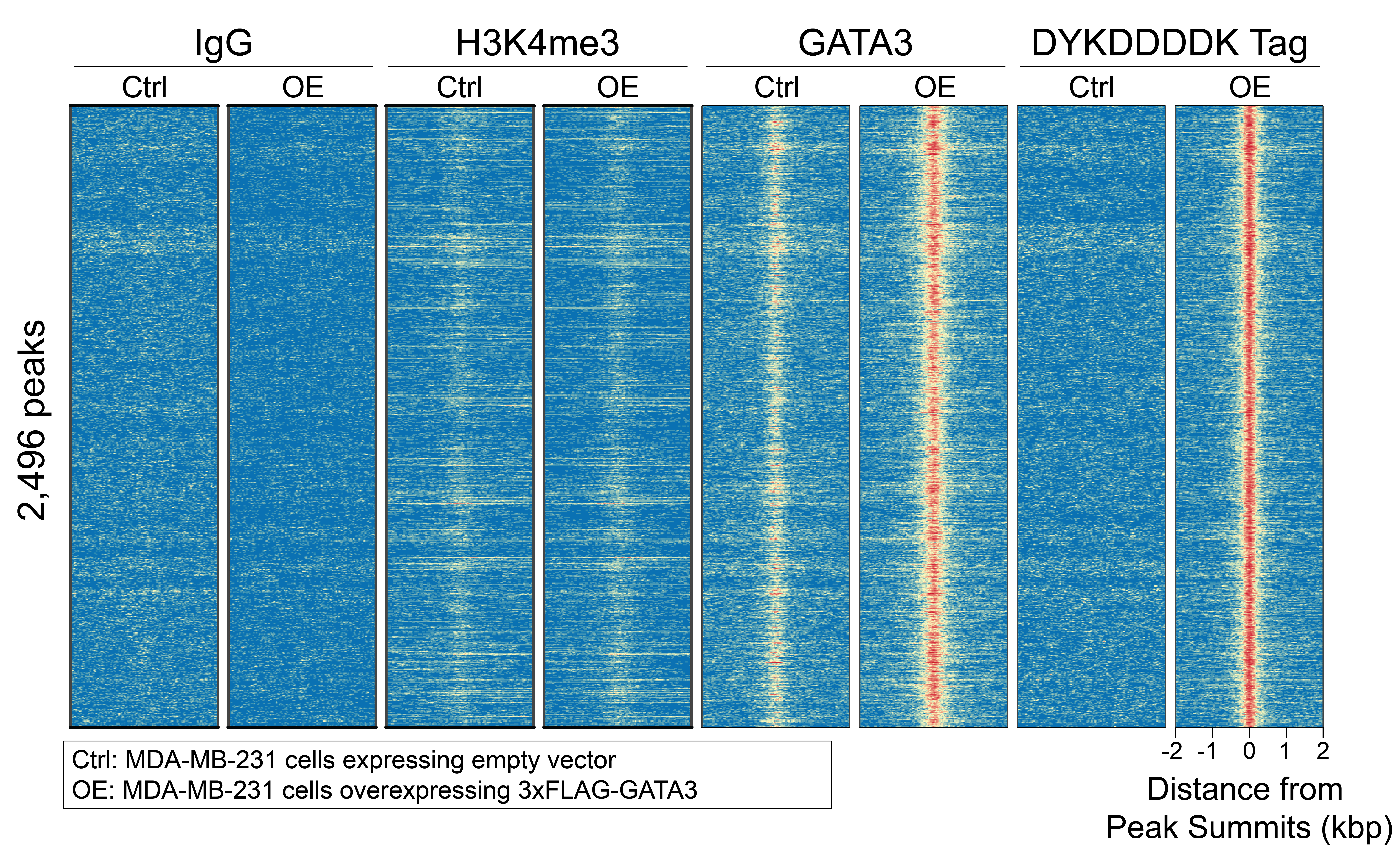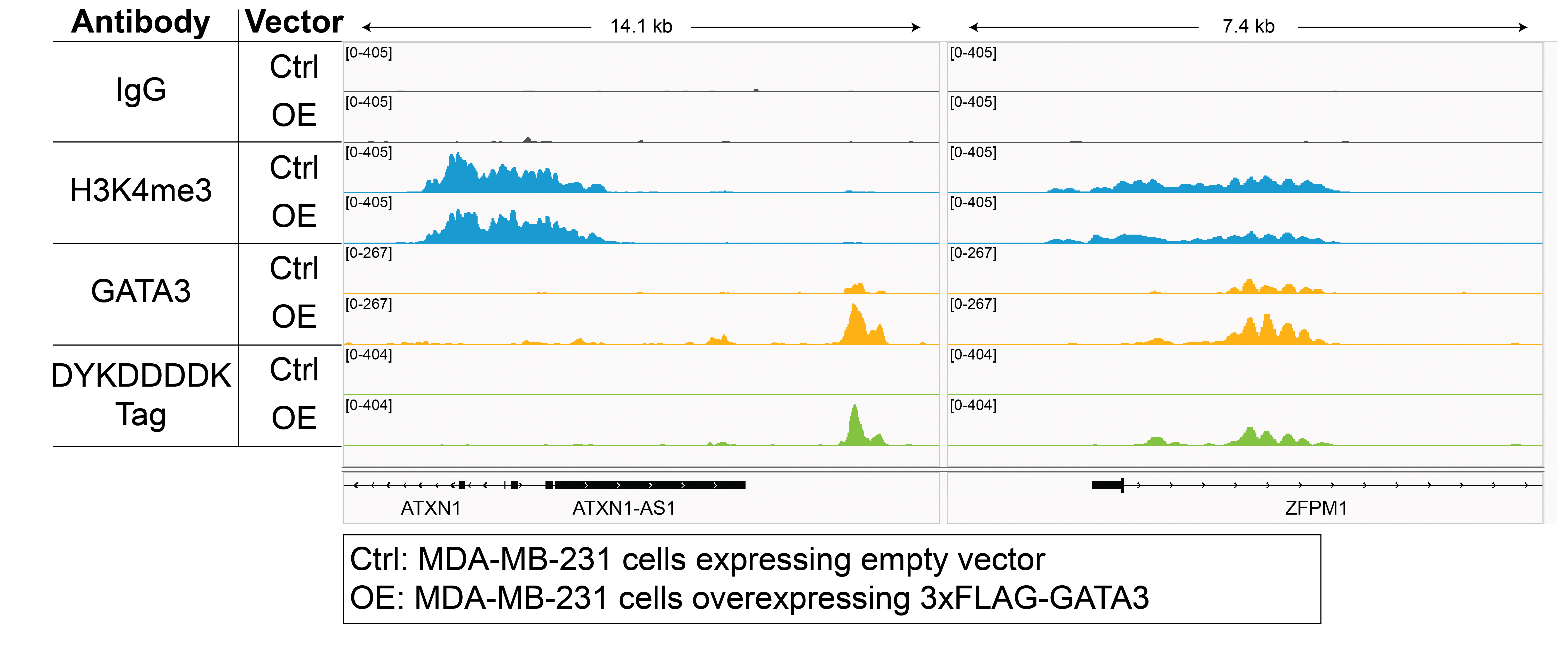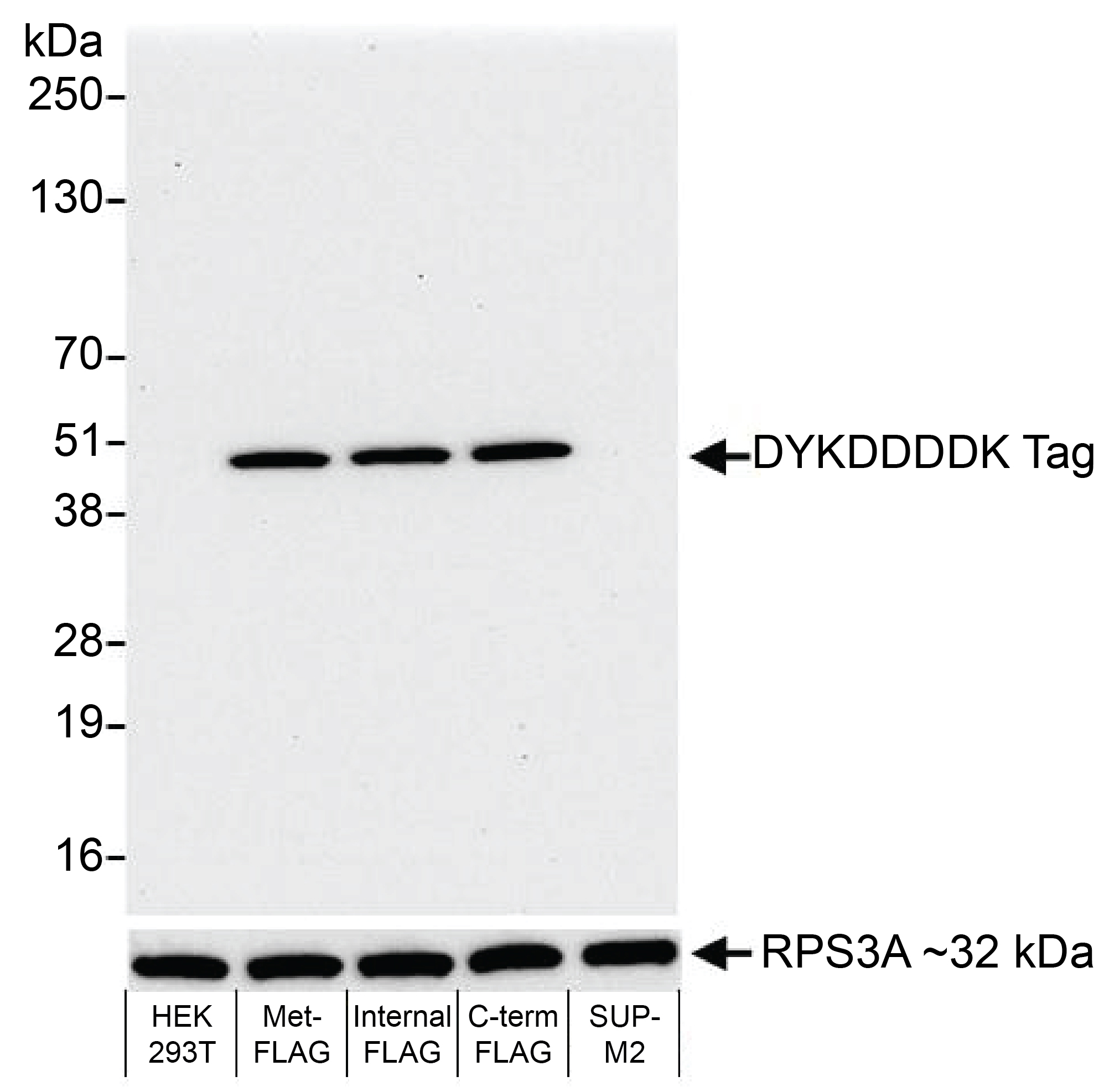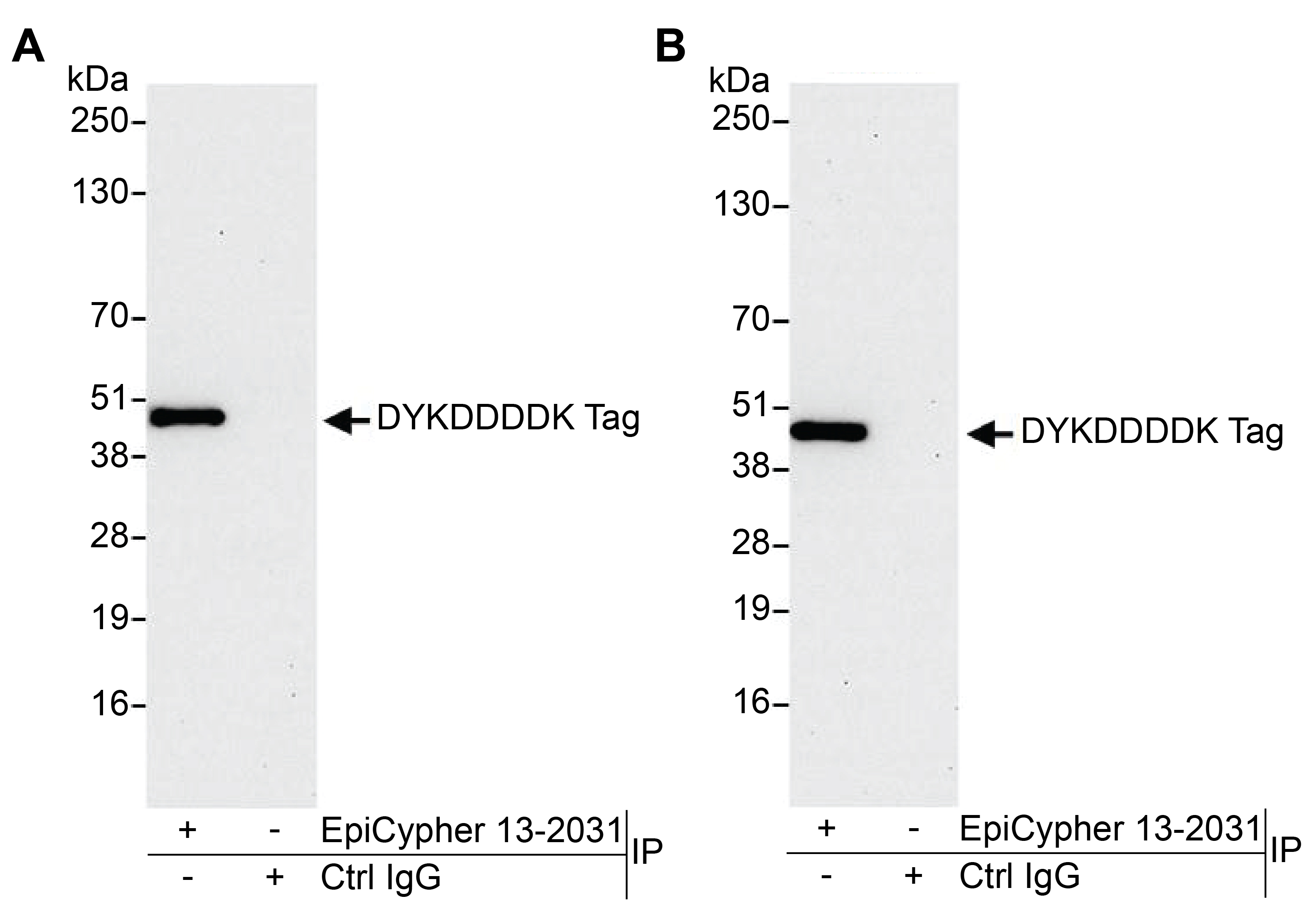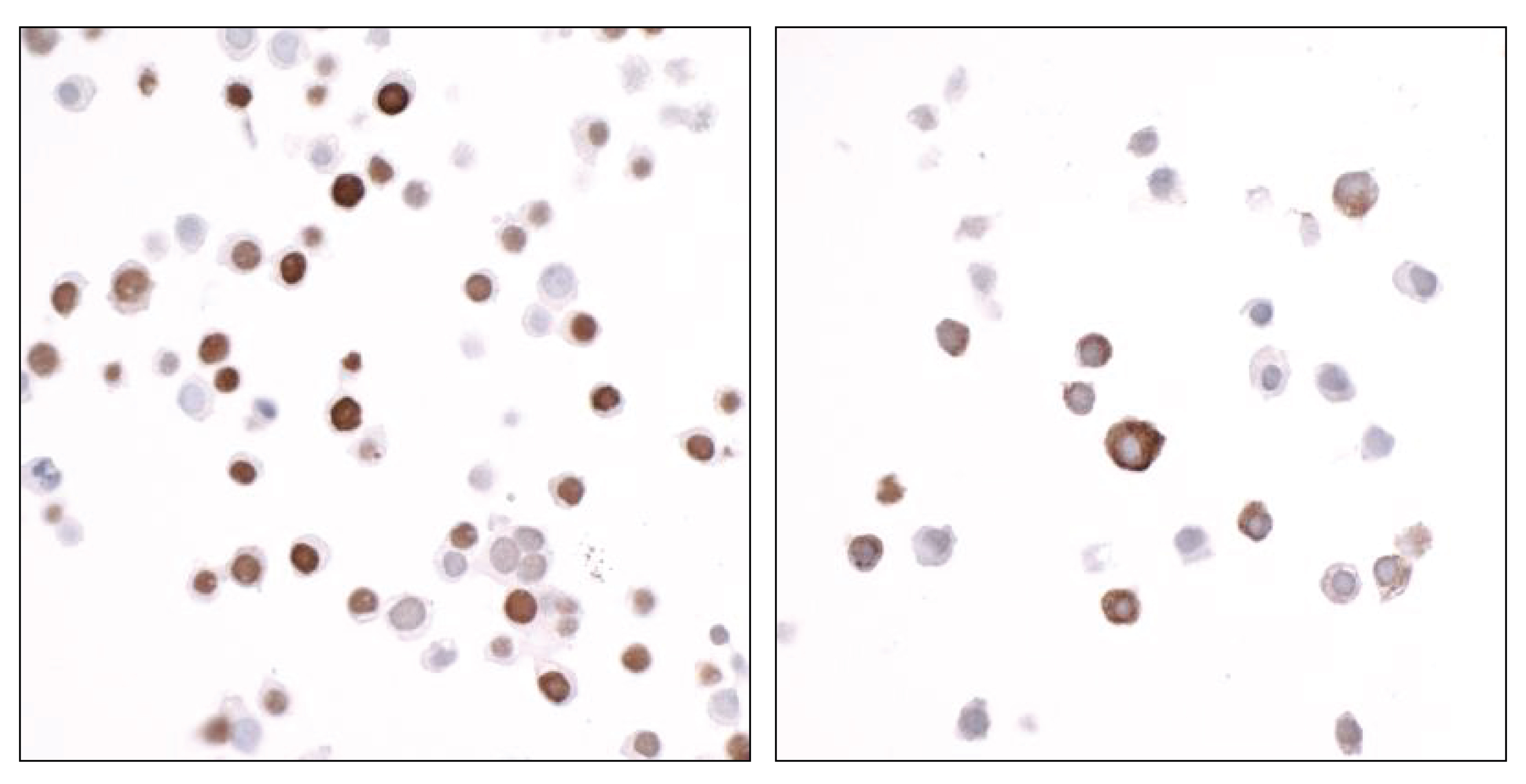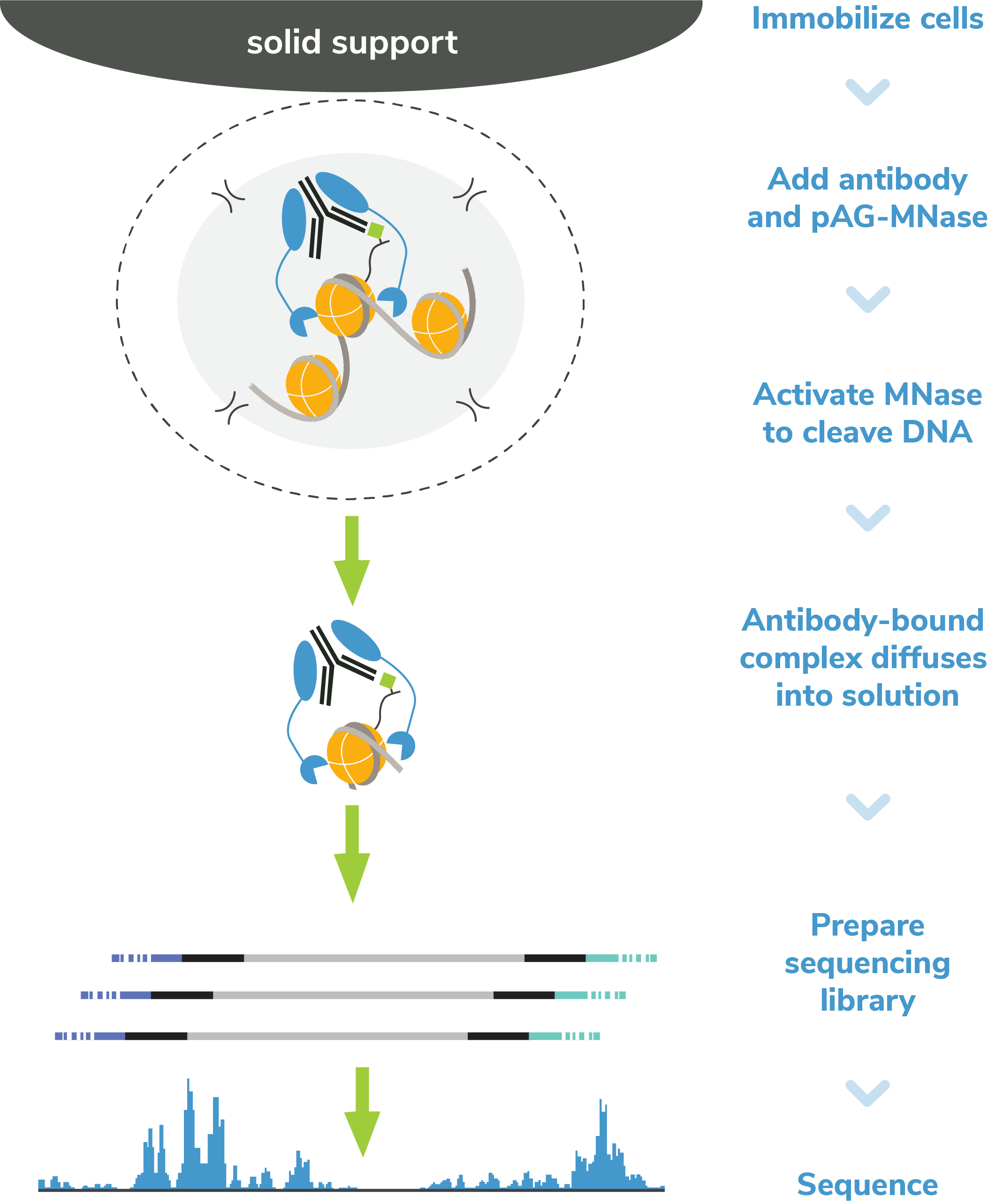
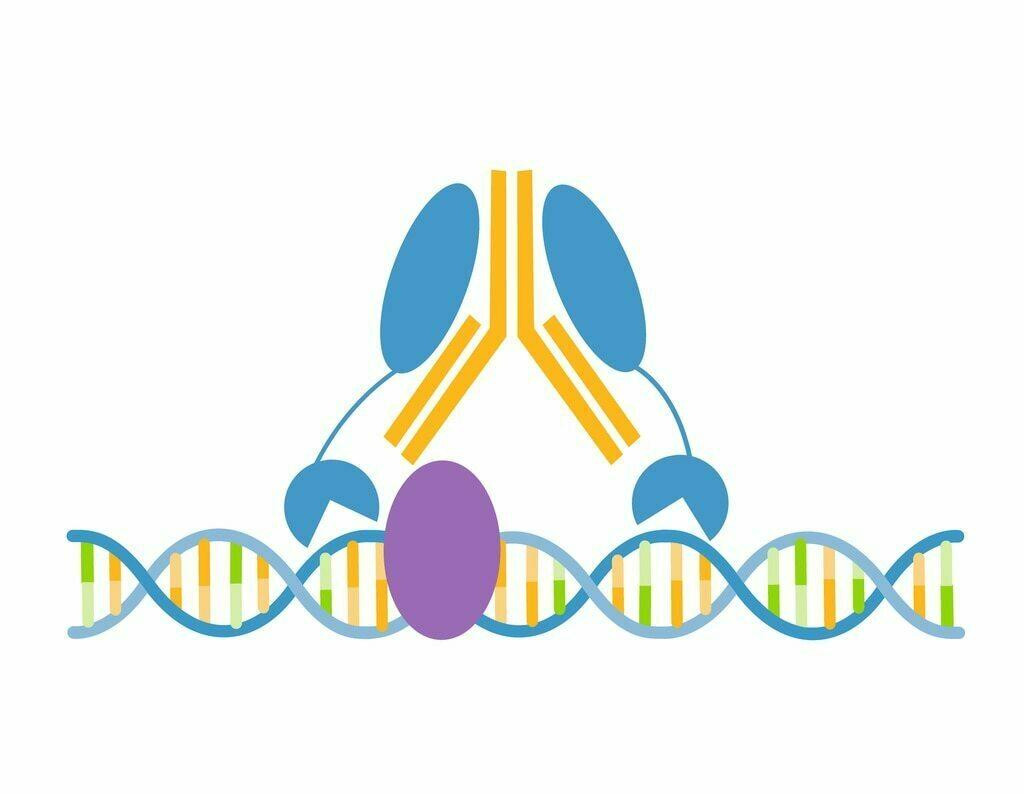
DYKDDDDK Tag CUTANA™ CUT&RUN Antibody
{"url":"https://www.epicypher.com/products/epigenetics-kits-and-reagents/cutana-chic-cut-run-assays/dykddddk-tag-cutana-cut-and-run-antibody","add_this":[{"service":"facebook","annotation":""},{"service":"email","annotation":""},{"service":"print","annotation":""},{"service":"twitter","annotation":""},{"service":"linkedin","annotation":""}],"gtin":"","id":"1136","bulk_discount_rates":[],"can_purchase":true,"meta_description":"Rabbit monoclonal DYKDDDDK Tag antibody rigorously tested for robust and reliable performance in CUT&RUN assays. Also validated for ELISA, WB, IP, & ICC.","category":["Antibodies/CUTANA™ CUT&RUN Antibodies","Antibodies/CUTANA™ CUT&RUN Antibodies/CUT&RUN Antibodies - Chromatin-Associated Proteins","Epigenetics Kits and Reagents/CUTANA™ ChIC / CUT&RUN Assays"],"AddThisServiceButtonMeta":"","main_image":{"data":"https://cdn11.bigcommerce.com/s-y9o92/images/stencil/{:size}/products/1136/1207/ha-tag-cutana-cutandrun-antibody__18433.1706257992.jpg?c=2","alt":"HA Tag CUTANA CUTandRUN Antibody"},"add_to_wishlist_url":"/wishlist.php?action=add&product_id=1136","shipping":{"calculated":true},"num_reviews":0,"weight":"0.00 LBS","custom_fields":[{"id":"1301","name":"Pack Size","value":"100 µL"}],"sku":"13-2031","description":"<div class=\"product-general-info\">\n <ul class=\"product-general-info__list-left\">\n <li class=\"product-general-info__list-item\">\n <strong>Type: </strong>Monoclonal\n </li>\n <li class=\"product-general-info__list-item\">\n <strong>Host: </strong>Rabbit\n </li>\n <li class=\"product-general-info__list-item\">\n <strong>Applications: </strong>CUT&RUN, ELISA, WB, IP, ICC\n </li>\n </ul>\n <ul class=\"product-general-info__list-right\">\n <li class=\"product-general-info__list-item\">\n <strong>Reactivity: </strong>FLAG® Epitope (DYKDDDDK)\n </li>\n <li class=\"product-general-info__list-item\">\n <strong>Format: </strong>Antigen affinity-purified\n </li>\n <li class=\"product-general-info__list-item\">\n <strong>Target Size: </strong>N/A\n </li>\n </ul>\n <!-- <ul style=\"padding: 0\" class=\"product-general-info__list-right\">\n <li class=\"product-general-info__list-item\">\n <a href=\"#bioz\">\n <div id=\"w-s-3835-13-2010\" style=\"\n width: 240px;\n height: 58px;\n position: relative;\n overflow-y: hidden;\n \"></div>\n <div id=\"bioz-w-pb-13-2010-div\" style=\"width: 240px\">\n <a id=\"bioz-w-pb-13-2010\" style=\"font-size: 12px; color: transparent\" href=\"https://www.bioz.com/\"\n target=\"_blank\">\n <img src=\"https://cdn.bioz.com/assets/favicon.png\" style=\"\n width: 11px;\n height: 11px;\n vertical-align: baseline;\n padding-bottom: 0px;\n margin-left: 0px;\n margin-bottom: 0px;\n float: none;\n display: none;\n \" />\n Powered by Bioz\n </a>\n </div>\n </a>\n </li>\n </ul> -->\n</div>\n<div class=\"service_accordion product-droppdown\">\n <div class=\"container\">\n <div id=\"prodAccordion\">\n <div id=\"ProductDescription\" class=\"Block Panel current\">\n <h3 class=\"sub-title1\">Description</h3>\n <div class=\"ProductDescriptionContainer product-droppdown__section-description-specific\">\n <p>\n DYKDDDDK antibody is useful for studies utilizing FLAG®*-tagged target proteins. This antibody meets\n EpiCypher's “CUTANA Compatible” criteria for performance in Cleavage Under Targets and Release Using\n Nuclease (CUT&RUN) and/or Cleavage Under Targets and Tagmentation (CUT&Tag) approaches to genomic mapping.\n Every lot of a CUTANA Compatible antibody is tested in the indicated approach using <a href=\"/resources/protocols/\" target=\"_blank\">EpiCypher optimized protocols</a> and determined to yield peaks that show a genomic distribution pattern consistent with reported function(s) of the target. DYKDDDDK Tag antibody produces CUT&RUN peaks (<strong>Figures 2-3</strong>) that overlap with GATA3 in breast cancer cells expressing 3xFLAG-tagged GATA3 transcription factor [1]**.\n </p>\n <p style=\"\n background-color: #4698cb;\n color: #fff;\n padding: 1.3rem;\n text-align: center;\n border-radius: 12px;\n \">\n <a target=\"_blank\" style=\"color: #fff;\" href=\"/products/nucleosomes/snap-cutana-dykddddk-tag-panel\">Pair\n with our SNAP-CUTANA™ DYKDDDDK Tag Panel for CUT&RUN success. Check it out here.\n </a>\n </p>\n <i>*FLAG® is a registered trademark of Merck KGaA, Darmstadt, Germany.</i><br>\n <i>**Thanks to Dr. Takaku (UND) for 3xFLAG-GATA3-3xHA MDA-MB-231 cells.</i>\n </div>\n </div>\n </div>\n <div id=\"prodAccordion\">\n <div id=\"ProductDescription\" class=\"Block Panel current\">\n <h3 class=\"sub-title1\">Validation Data</h3>\n <div class=\"ProductDescriptionContainer product-droppdown__section-description-specific\">\n <section class=\"image-picker\">\n <div class=\"image-picker__left\">\n <div class=\"image-picker__main-content_active image-picker__main-content\">\n <div class=\"image-picker__header-content\">\n <button class=\"image-picker__left-arrow\">\n <svg class=\"image-picker__svg-left\" width=\"24\" height=\"24\" viewBox=\"0 0 24 24\">\n <path d=\"M16.67 0l2.83 2.829-9.339 9.175 9.339 9.167-2.83 2.829-12.17-11.996z\" />\n </svg>\n </button>\n <a href=\"/content/images/products/antibodies/13-2031_dykddddk_tag_panel.jpeg\" target=\"_blank\"\n class=\"image-picker__main-image-link\"><img loading=\"lazy\" alt=\"13-2031_dykddddk_tag_panel\"\n src=\"/content/images/products/antibodies/13-2031_dykddddk_tag_panel.jpeg\"\n class=\"image-picker__main-image\" />\n <span class=\"image-picker__main-image-caption\">(Click to enlarge)</span></a>\n <button class=\"image-picker__right-arrow\">\n <svg class=\"image-picker__svg-right\" width=\"24\" height=\"24\" viewBox=\"0 0 24 24\">\n <path d=\"M7.33 24l-2.83-2.829 9.339-9.175-9.339-9.167 2.83-2.829 12.17 11.996z\" />\n </svg>\n </button>\n </div>\n <p>\n <span class=\"image-picker__span-content\"><strong>Figure 1: Defined nucleosome spike-ins provide an in-assay\n control for DYKDDDDK Tag antibody in CUT&RUN</strong><br />\n\n CUT&RUN was preformed as described in <strong>Figure 7</strong>. CUT&RUN sequencing reads were aligned to the unique DNA barcodes corresponding to each nucleosome in\n the SNAP-CUTANA™ DYKDDDDK Tag Panel (EpiCypher <a\n href=\"/products/antibodies/snap-cutana-dykddddk-tag-panel\" target=\"_blank\">19-5001</a>). Data are\n expressed as a percent relative to on-target recovery (DYKDDDDK Tag set to 100%) or total counts\n (IgG/GATA3). IgG/GATA3 show no preferential binding to unmodified or DYKDDDDK spike-in nucleosomes.\n DYKDDDDK Tag antibody selectively enriches the DYKDDDDK Tag spike-in nucleosome, validating the\n antibody in CUT&RUN.\n\n </span>\n </p>\n </div>\n <div class=\"image-picker__main-content\">\n <div class=\"image-picker__header-content\">\n <button class=\"image-picker__left-arrow\">\n <svg class=\"image-picker__svg-left\" width=\"24\" height=\"24\" viewBox=\"0 0 24 24\">\n <path d=\"M16.67 0l2.83 2.829-9.339 9.175 9.339 9.167-2.83 2.829-12.17-11.996z\" />\n </svg>\n </button>\n <a href=\"/content/images/products/antibodies/13-2031_protein_peaks.jpeg\" target=\"_blank\"\n class=\"image-picker__main-image-link\"><img loading=\"lazy\" alt=\"13-2031_protein_peaks\"\n src=\"/content/images/products/antibodies/13-2031_protein_peaks.jpeg\"\n class=\"image-picker__main-image\" />\n <span class=\"image-picker__main-image-caption\">(Click to enlarge)</span></a>\n <button class=\"image-picker__right-arrow\">\n <svg class=\"image-picker__svg-right\" width=\"24\" height=\"24\" viewBox=\"0 0 24 24\">\n <path d=\"M7.33 24l-2.83-2.829 9.339-9.175-9.339-9.167 2.83-2.829 12.17 11.996z\" />\n </svg>\n </button>\n </div>\n <p>\n <span class=\"image-picker__span-content\"><strong>Figure 2: DYKDDDDK-tagged protein peaks in\n CUT&RUN</strong><br />\n CUT&RUN was preformed as described in <strong>Figure 7</strong>. Heatmaps show DYKDDDDK Tag antibody-enriched peaks called for FLAG-GATA3 overexpressing cells\n (OE) in aligned rows relative to all other experimental conditions. Rows are ranked by intensity\n (top to bottom) and colored such that red indicates high localized enrichment and blue denotes\n background signal. A high degree of overlap is observed for DYKDDDDK and GATA3 antibodies as\n expected in the OE cells, while empty vector control (Ctrl) shows absence of FLAG and lower GATA3\n enrichment representing endogenous protein. IgG shows low background signal. H3K4me3, a canonical\n mark of promoters, does not appear in regions of high GATA3 enrichment.\n </span>\n </p>\n </div>\n\n <div class=\"image-picker__main-content\">\n <div class=\"image-picker__header-content\">\n <button class=\"image-picker__left-arrow\">\n <svg class=\"image-picker__svg-left\" width=\"24\" height=\"24\" viewBox=\"0 0 24 24\">\n <path d=\"M16.67 0l2.83 2.829-9.339 9.175 9.339 9.167-2.83 2.829-12.17-11.996z\" />\n </svg>\n </button>\n <a href=\"/content/images/products/antibodies/13-2031_browser_tracks.jpeg\" target=\"_blank\"\n class=\"image-picker__main-image-link\"><img loading=\"lazy\" alt=\"13-2031_browser_tracks\"\n src=\"/content/images/products/antibodies/13-2031_browser_tracks.jpeg\"\n class=\"image-picker__main-image\" />\n <span class=\"image-picker__main-image-caption\">(Click to enlarge)</span></a>\n <button class=\"image-picker__right-arrow\">\n <svg class=\"image-picker__svg-right\" width=\"24\" height=\"24\" viewBox=\"0 0 24 24\">\n <path d=\"M7.33 24l-2.83-2.829 9.339-9.175-9.339-9.167 2.83-2.829 12.17 11.996z\" />\n </svg>\n </button>\n </div>\n <p>\n <span class=\"image-picker__span-content\"><strong>Figure 3: CUT&RUN representative browser tracks for\n DYKDDDDK-tagged protein</strong><br />\n CUT&RUN was preformed as described in <strong>Figure 7</strong>. Gene browser shots were generated using the Integrative Genomics Viewer (IGV, Broad Institute). Two\n of the top called peaks in FLAG-GATA3 overexpressing (OE) cells are shown. The peaks show the\n same distribution patterns as observed in the genome-wide heatmaps (<strong>Figure 2</strong>). IgG\n shows low background, H3K4me3 is unchanged between empty vector control (Ctrl) and OE cells, GATA3\n peaks are more robust in OE cells, and peaks overlap between GATA3 and DYKDDDDK antibodies in OE\n cells. These results demonstrate the robustness and specificity of DYKDDDDK Tag antibody in CUT&RUN\n experiments targeting FLAG-tagged proteins.\n </span>\n </p>\n </div>\n <div class=\"image-picker__main-content\">\n <div class=\"image-picker__header-content\">\n <button class=\"image-picker__left-arrow\">\n <svg class=\"image-picker__svg-left\" width=\"24\" height=\"24\" viewBox=\"0 0 24 24\">\n <path d=\"M16.67 0l2.83 2.829-9.339 9.175 9.339 9.167-2.83 2.829-12.17-11.996z\" />\n </svg>\n </button>\n <a href=\"/content/images/products/antibodies/13-2031_western_blot.jpeg\" target=\"_blank\"\n class=\"image-picker__main-image-link\"><img loading=\"lazy\" alt=\"13-2013_western_blot\"\n src=\"/content/images/products/antibodies/13-2031_western_blot.jpeg\"\n class=\"image-picker__main-image\" />\n <span class=\"image-picker__main-image-caption\">(Click to enlarge)</span></a>\n <button class=\"image-picker__right-arrow\">\n <svg class=\"image-picker__svg-right\" width=\"24\" height=\"24\" viewBox=\"0 0 24 24\">\n <path d=\"M7.33 24l-2.83-2.829 9.339-9.175-9.339-9.167 2.83-2.829 12.17 11.996z\" />\n </svg>\n </button>\n </div>\n <p>\n <span class=\"image-picker__span-content\"><strong>Figure 4: Western blot data\n </strong><br />\n Western analysis of FLAG-tagged protein in lysates from non-transfected human HEK293 cells,\n HEK293 transfected with Met-FLAG-IDO1, HEK293 transfected with IDO1-FLAG-HIS (Internal Tag), HEK293\n transfected with IDO1-HIS-FLAG (C-Terminal Tag), and SUP-M2 cells. EpiCypher DYKDDDDK Tag antibody was\n used at 1:1,000. An HRP-conjugated goat anti-rabbit IgG antibody (Fortis A120-101P) was used as a\n secondary antibody. Chemiluminescence exposure time was 10 seconds. Lower panel shows rabbit\n anti-RPS3A antibody results (Fortis A305-003A).\n </span>\n </p>\n </div>\n <div class=\"image-picker__main-content\">\n <div class=\"image-picker__header-content\">\n <button class=\"image-picker__left-arrow\">\n <svg class=\"image-picker__svg-left\" width=\"24\" height=\"24\" viewBox=\"0 0 24 24\">\n <path d=\"M16.67 0l2.83 2.829-9.339 9.175 9.339 9.167-2.83 2.829-12.17-11.996z\" />\n </svg>\n </button>\n <a href=\"/content/images/products/antibodies/13-2031_immunoprecipitation.jpeg\" target=\"_blank\"\n class=\"image-picker__main-image-link\"><img loading=\"lazy\" alt=\"13-2031_immunoprecipitation\"\n src=\"/content/images/products/antibodies/13-2031_immunoprecipitation.jpeg\"\n class=\"image-picker__main-image\" />\n <span class=\"image-picker__main-image-caption\">(Click to enlarge)</span></a>\n <button class=\"image-picker__right-arrow\">\n <svg class=\"image-picker__svg-right\" width=\"24\" height=\"24\" viewBox=\"0 0 24 24\">\n <path d=\"M7.33 24l-2.83-2.829 9.339-9.175-9.339-9.167 2.83-2.829 12.17 11.996z\" />\n </svg>\n </button>\n </div>\n <p>\n <span class=\"image-picker__span-content\"><strong>Figure 5: Immunoprecipitation data</strong><br />\n EpiCypher DYKDDDDK Tag antibody (20 µL/mg lysate) was used to immunoprecipitate lysates isolated\n from HEK293 cells transfected with either Met-FLAG-IDO1 (<strong>A</strong>) or IDO1-HIS-FLAG\n (C-terminal tag; <strong>B</strong>). For blotting immunoprecipitated DYKDDDDK Tag, EpiCypher\n DYKDDDDK Tag antibody was used at 1:1,000. Chemiluminescence exposure time was 10 seconds.\n\n </span>\n </p>\n </div>\n\n <div class=\"image-picker__main-content\">\n <div class=\"image-picker__header-content\">\n <button class=\"image-picker__left-arrow\">\n <svg class=\"image-picker__svg-left\" width=\"24\" height=\"24\" viewBox=\"0 0 24 24\">\n <path d=\"M16.67 0l2.83 2.829-9.339 9.175 9.339 9.167-2.83 2.829-12.17-11.996z\" />\n </svg>\n </button>\n <a href=\"/content/images/products/antibodies/13-2031_immunocytochemistry.jpeg\" target=\"_blank\"\n class=\"image-picker__main-image-link\"><img loading=\"lazy\" alt=\"13-2031_immunocytochemistry\"\n src=\"/content/images/products/antibodies/13-2031_immunocytochemistry.jpeg\"\n class=\"image-picker__main-image\" />\n <span class=\"image-picker__main-image-caption\">(Click to enlarge)</span></a>\n <button class=\"image-picker__right-arrow\">\n <svg class=\"image-picker__svg-right\" width=\"24\" height=\"24\" viewBox=\"0 0 24 24\">\n <path d=\"M7.33 24l-2.83-2.829 9.339-9.175-9.339-9.167 2.83-2.829 12.17 11.996z\" />\n </svg>\n </button>\n </div>\n <p>\n <span class=\"image-picker__span-content\"><strong>Figure 6: Immunocytochemistry data\n </strong><br />\n FFPE sections of HEK293 cells expressing either FLAG-tagged nuclear protein (<strong>left</strong>)\n or FLAG-tagged cytoplasmic protein (<strong>right</strong>) using EpiCypher DYKDDDDK Tag\n antibody. An HRP-conjugated goat anti-rabbit IgG antibody (Fortis A120-501P) was used as a secondary\n antibody. The substrate used was DAB.\n </span>\n </p>\n </div>\n\n <div class=\"image-picker__main-content\">\n <div class=\"image-picker__header-content\">\n <button class=\"image-picker__left-arrow\">\n <svg class=\"image-picker__svg-left\" width=\"24\" height=\"24\" viewBox=\"0 0 24 24\">\n <path d=\"M16.67 0l2.83 2.829-9.339 9.175 9.339 9.167-2.83 2.829-12.17-11.996z\" />\n </svg>\n </button>\n <a href=\"/content/images/products/antibodies/13-2031_cr_workflow.png\" target=\"_blank\"\n class=\"image-picker__main-image-link\"><img loading=\"lazy\" alt=\"13-2031_cr_workflow\"\n src=\"/content/images/products/antibodies/13-2031_cr_workflow.png\"\n class=\"image-picker__main-image\" />\n <span class=\"image-picker__main-image-caption\">(Click to enlarge)</span></a>\n <button class=\"image-picker__right-arrow\">\n <svg class=\"image-picker__svg-right\" width=\"24\" height=\"24\" viewBox=\"0 0 24 24\">\n <path d=\"M7.33 24l-2.83-2.829 9.339-9.175-9.339-9.167 2.83-2.829 12.17 11.996z\" />\n </svg>\n </button>\n </div>\n <p>\n <span class=\"image-picker__span-content\"><strong>Figure 7: CUT&RUN methods </strong><br />\n\n CUT&RUN was performed on 500k MDA-MB-231 native cells either stably overexpressing 3xFLAG-tagged\n GATA3 [1] or containing vector control. Either DYKDDDDK Tag (0.05 µg), H3K4me3 (0.5 µg; EpiCypher <a\n href=\"https://www.epicypher.com/products/antibodies/snap-chip-certified-antibodies/histone-h3k4me3-antibody-snap-chip-certified-cutana-cut-run-compatible\"\n target=\"_blank\">13-0041)</a>, GATA3 (0.5 µg; CST 5852), or IgG (0.5 µg, EpiCypher <a\n href=\"/products/nucleosomes/snap-cutana-spike-in-controls/cutana-igg-negative-control-antibody-for-cut-run-and-cut-tag\"\n target=\"_blank\">13-0042</a>) antibodies were used with the CUTANA™ ChIC/CUT&RUN Kit v3 (EpiCypher\n <a href=\"/products/epigenetics-reagents-and-assays/cutana-chic-cut-and-run-kit\"\n target=\"_blank\">14-1048</a>). Library preparation was performed with 5 ng of DNA (or the total\n amount recovered if less than 5 ng) using the CUTANA™ CUT&RUN Library Prep Kit (EpiCypher <a\n href=\"/products/epigenetics-reagents-and-assays/cutana-cut-and-run-library-prep-kit\"\n target=\"_blank\">14-1001/14-1002</a>). Libraries were run on an Illumina NextSeq2000 with\n paired-end sequencing (2x50 bp). Sample sequencing depth (vector control cells/overexpressing cells)\n was 5.6/4.5 million reads (IgG), 7.8/6.7 million reads (H3K4me3), 5.8/4.7 million reads (GATA3), and\n 6.2/5.5 million reads (DYKDDDDK Tag). Data were aligned to the hg19 genome using Bowtie2. Data were\n filtered to remove duplicates, multi-aligned reads, and ENCODE DAC Exclusion List regions.\n\n </span>\n </p>\n </div>\n </div>\n <aside class=\"image-picker__right\">\n <div class=\"image-picker__gallery\">\n <img loading=\"lazy\" alt=\"13-2031_dykddddk_tag_panel\"\n src=\"/content/images/products/antibodies/13-2031_dykddddk_tag_panel.jpeg\" width=\"200\"\n class=\"image-picker__side-image image-picker__side-image_active\" role=\"button\" />\n <img loading=\"lazy\" alt=\"13-2031_protein_peaks\"\n src=\"/content/images/products/antibodies/13-2031_protein_peaks.jpeg\" class=\"image-picker__side-image\"\n role=\"button\" />\n <img loading=\"lazy\" alt=\"13-2031_browser_tracks\"\n src=\"/content/images/products/antibodies/13-2031_browser_tracks.jpeg\" class=\"image-picker__side-image\"\n role=\"button\" />\n <img loading=\"lazy\" alt=\"13-2031_western_blot\"\n src=\"/content/images/products/antibodies/13-2031_western_blot.jpeg\" class=\"image-picker__side-image\"\n role=\"button\" />\n <img loading=\"lazy\" alt=\"13-2031_immunoprecipitation\"\n src=\"/content/images/products/antibodies/13-2031_immunoprecipitation.jpeg\"\n class=\"image-picker__side-image\" role=\"button\" />\n <img loading=\"lazy\" alt=\"13-2031_immunocytochemistry\"\n src=\"/content/images/products/antibodies/13-2031_immunocytochemistry.jpeg\"\n class=\"image-picker__side-image\" role=\"button\" />\n <img loading=\"lazy\" alt=\"13-2031_cr_workflow\"\n src=\"/content/images/products/antibodies/13-2031_cr_workflow.png\" class=\"image-picker__side-image\"\n role=\"button\" />\n </div>\n </aside>\n </section>\n </div>\n </div>\n </div>\n <div id=\"prodAccordion\">\n <div id=\"ProductDescription\" class=\"Block Panel\">\n <h3 class=\"sub-title1\">Technical Information</h3>\n <div class=\"ProductDescriptionContainer product-droppdown__section-description\">\n <div class=\"product-tech-info\">\n <div class=\"product-tech-info__line-item\">\n <div class=\"product-tech-info__line-item-left\">\n <b>Immunogen</b>\n </div>\n <div class=\"product-tech-info__line-item-right\">\n A synthetic peptide sequence (DYKDDDDK)\n\n </div>\n </div>\n <div class=\"product-tech-info__line-item\">\n <div class=\"product-tech-info__line-item-left\">\n <b>Storage</b>\n </div>\n <div class=\"product-tech-info__line-item-right\">\n Stable for 1 year at 4°C from date of receipt\n\n </div>\n </div>\n <div class=\"product-tech-info__line-item\">\n <div class=\"product-tech-info__line-item-left\">\n <b>Formulation</b>\n </div>\n <div class=\"product-tech-info__line-item-right\">\n Antigen affinity-purified recombinant monoclonal antibody in borate buffered saline (BBS) pH 8.2, 0.1%\n BSA, 0.09% sodium azide\n </div>\n </div>\n </div>\n </div>\n </div>\n </div>\n <div id=\"prodAccordion\">\n <div id=\"ProductDescription\" class=\"Block Panel\">\n <h3 class=\"sub-title1\">Recommended Dilution</h3>\n <div class=\"ProductDescriptionContainer product-droppdown__section-description\">\n <div class=\"product-tech-info\">\n <div class=\"product-tech-info__line-item\">\n <div class=\"product-tech-info__line-item-left\">\n <b>CUT&RUN</b>\n </div>\n <div class=\"product-tech-info__line-item-right\">\n 0.05 µg per reaction (0.5 µL of 100 µg/mL antibody)\n </div>\n </div>\n <div class=\"product-tech-info__line-item\">\n <div class=\"product-tech-info__line-item-left\">\n <b>Enzyme Immunosorbent Assay (ELISA) </b>\n </div>\n <div class=\"product-tech-info__line-item-right\">\n 1:1,000 - 1:75,000; for coating plates 1:100 - 1:500\n </div>\n </div>\n <div class=\"product-tech-info__line-item\">\n <div class=\"product-tech-info__line-item-left\">\n <b>Western Blot (WB)\n </b>\n </div>\n <div class=\"product-tech-info__line-item-right\">\n 1:1,000\n </div>\n </div>\n <div class=\"product-tech-info__line-item\">\n <div class=\"product-tech-info__line-item-left\">\n <b>Immunoprecipitation (IP) </b>\n </div>\n <div class=\"product-tech-info__line-item-right\">\n 20 µL/mg lysate\n </div>\n </div>\n <div class=\"product-tech-info__line-item\">\n <div class=\"product-tech-info__line-item-left\">\n <b>Immunocytochemistry (ICC)\n </b>\n </div>\n <div class=\"product-tech-info__line-item-right\">\n 1:1,000 - 1:5,000. Epitope retrieval with citrate buffer pH 6.0 is recommended for FFPE cell sections\n </div>\n </div>\n </div>\n </div>\n </div>\n </div>\n <div id=\"prodAccordion\">\n <div id=\"ProductDescription\" class=\"Block Panel\">\n <h3 class=\"sub-title1\">References</h3>\n <div class=\"ProductDescriptionContainer product-droppdown__section-description\">\n <strong>Background References:</strong>\n <br />\n [1] Takaku et al. <em>Genome Biol.</em> (2016). PMID:\n <a href=\"https://pubmed.ncbi.nlm.nih.gov/26922637/\"\n title=\"Expression and Purification of Recombinant Histones and Nucleosome Reconstitution\" target=\"new\">\n 26922637</a><br />\n </div>\n </div>\n </div>\n <div id=\"prodAccordion\">\n <div id=\"ProductDescription\" class=\"Block Panel\">\n <h3 class=\"sub-title1\">Documents & Resources</h3>\n <div class=\"ProductDescriptionContainer product-droppdown__section-description\">\n <div class=\"product-documents\">\n <a href=\"/content/documents/tds/13-2031.pdf\" target=\"_blank\" class=\"product-documents__link\">\n <svg version=\"1.1\" id=\"Layer_1\" xmlns=\"http://www.w3.org/2000/svg\"\n xmlns:xlink=\"http://www.w3.org/1999/xlink\" x=\"0px\" y=\"0px\" viewBox=\"0 0 228 240\"\n style=\"enable-background: new 0 0 228 240\" xml:space=\"preserve\" class=\"product-documents__icon\">\n <g>\n <path class=\"product-documents__svg-pdf\"\n d=\"M191.92,68.77l-47.69-47.69c-1.33-1.33-3.12-2.08-5.01-2.08H45.09C41.17,19,38,22.17,38,26.09v184.36\n c0,3.92,3.17,7.09,7.09,7.09h141.82c3.92,0,7.09-3.17,7.09-7.09V73.8C194,71.92,193.25,70.1,191.92,68.77z M177.65,77.06h-41.7\n v-41.7L177.65,77.06z M178.05,201.59H53.95V34.95h66.92v47.86c0,5.14,4.17,9.31,9.31,9.31h47.86V201.59z\" />\n </g>\n <rect x=\"20\" y=\"112\" class=\"product-documents__svg-background\" width=\"146\" height=\"76\" />\n <g>\n <path class=\"product-documents__svg-pdf\" d=\"M23.83,125.68h22.36c5.29,0,9.41,1.33,12.35,4c2.94,2.67,4.42,6.39,4.42,11.18c0,4.78-1.47,8.51-4.42,11.18\n c-2.94,2.67-7.06,4-12.35,4H34.59v18.29H23.83V125.68z M44.81,147.9c5.38,0,8.07-2.32,8.07-6.97c0-2.39-0.67-4.16-2-5.31\n c-1.33-1.15-3.36-1.73-6.07-1.73H34.59v14.01H44.81z\" />\n <path class=\"product-documents__svg-pdf\"\n d=\"M69.92,125.68h18.91c5.29,0,9.84,0.97,13.66,2.9c3.82,1.93,6.74,4.72,8.76,8.35\n c2.02,3.63,3.04,7.98,3.04,13.04c0,5.06-1,9.42-3,13.08c-2,3.66-4.91,6.45-8.73,8.38c-3.82,1.93-8.4,2.9-13.73,2.9H69.92V125.68z\n M88.07,165.63c10.35,0,15.52-5.22,15.52-15.66c0-10.4-5.17-15.59-15.52-15.59h-7.38v31.26H88.07z\" />\n <path class=\"product-documents__svg-pdf\"\n d=\"M122.57,125.68h32.84v8.49h-22.22v11.18h20.84v8.49h-20.84v20.49h-10.63V125.68z\" />\n </g>\n </svg>\n <span class=\"product-documents__info\">Technical Datasheet</span>\n </a>\n </div>\n </div>\n </div>\n </div>\n <div id=\"prodAccordion\">\n <div id=\"ProductDescription\" class=\"Block Panel\">\n <h3 class=\"sub-title1\">Additional Info</h3>\n <div class=\"ProductDescriptionContainer product-droppdown__section-description\">\n <p>\n Clone BLRE00G is provided for commercial sale under license from Bethyl Laboratories, Inc. with additional\n lot-specific validation in CUT&RUN performed by EpiCypher.\n </p>\n </div>\n </div>\n </div>\n <!-- <div id=\"prodAccordion\">\n <div id=\"ProductDescription\" class=\"Block Panel current\">\n <h3 id=\"bioz\" style=\"padding-bottom: 5px; margin-top: 1rem\" class=\"sub-title1\">\n Product References\n </h3>\n\n <div class=\"ProductDescriptionContainer product-droppdown__section-description-specific\">\n <object id=\"wobj-3835-13-2010-q\" type=\"text/html\" data=\"https://www.bioz.com/v_widget_6_0/3835/13-2010/\"\n style=\"width: 100%; height: 193px\"></object>\n <div id=\"bioz-w-pb-3835-13-2010-q-div\" style=\"width: 100%\">\n <a id=\"bioz-w-pb-3835-13-2010-q\" style=\"\n font-size: 12px;\n text-decoration: none;\n color: #4698cb;\n \" href=\"https://www.bioz.com/\" target=\"_blank\"><img src=\"https://cdn.bioz.com/assets/favicon.png\"\n style=\"\n width: 11px;\n height: 11px;\n vertical-align: baseline;\n padding-bottom: 0px;\n margin-left: 0px;\n margin-bottom: 0px;\n float: none;\n \" />\n Powered by Bioz</a>\n <a style=\"\n font-size: 12px;\n text-decoration: none;\n float: right;\n color: transparent;\n \" href=\"https://www.bioz.com/result/13-2010/product/EpiCypher/?cn=13-2010\" target=\"_blank\">\n See more details on Bioz</a>\n </div>\n </div>\n </div>\n </div> -->\n </div>\n</div>\n<!-- <script>\n $(document).ready(function () {\n var widget_micro_obj = new v_widget_obj(\"s\", [1]);\n widget_micro_obj.request_catalog_number_widget_data_internal(\n \"13-2031\",\n \"13-2031\"\n );\n });\n</script> -->\n<style>\n /* .bioz-w-header td {\n padding: 0;\n }\n\n td table {\n margin: 0;\n padding: 6px !important;\n } */\n\n @media (min-width:1024px) {\n .product-general-info .product-general-info__list-item {\n white-space: nowrap;\n }\n }\n</style>","tags":[],"warranty":"","price":{"without_tax":{"formatted":"$495.00","value":495,"currency":"USD"},"tax_label":"Sales Tax"},"detail_messages":"","availability":"","page_title":"DYKDDDDK Tag Antibody | CUTANA™ CUT&RUN Compatible","cart_url":"https://www.epicypher.com/cart.php","max_purchase_quantity":0,"mpn":"","upc":null,"options":[],"related_products":[{"id":772,"sku":"14-1048","name":"CUTANA™ ChIC/CUT&RUN Kit","url":"https://www.epicypher.com/products/epigenetics-reagents-and-assays/cutana-chic-cut-and-run-kit","availability":"","rating":null,"brand":{"name":null},"category":["Epigenetics Kits and Reagents","Epigenetics Kits and Reagents/CUTANA™ ChIC / CUT&RUN Assays"],"summary":"\n \n \n \n \n \n \n \n ","image":{"data":"https://cdn11.bigcommerce.com/s-y9o92/images/stencil/{:size}/products/772/998/Epicypher_CUTANA_CUTRUN_Box__31908.1646406725.png?c=2","alt":"CUTANA™ ChIC/CUT&RUN Kit"},"images":[{"data":"https://cdn11.bigcommerce.com/s-y9o92/images/stencil/{:size}/products/772/998/Epicypher_CUTANA_CUTRUN_Box__31908.1646406725.png?c=2","alt":"CUTANA™ ChIC/CUT&RUN Kit"}],"date_added":"13th Aug 2020","pre_order":false,"show_cart_action":true,"has_options":false,"stock_level":null,"low_stock_level":null,"qty_in_cart":0,"custom_fields":[{"id":588,"name":"Pack size","value":"48 Reactions"}],"num_reviews":null,"weight":{"formatted":"0.01 LBS","value":0.01},"demo":false,"add_to_cart_url":"https://www.epicypher.com/cart.php?action=add&product_id=772","price":{"without_tax":{"currency":"USD","formatted":"$945.00","value":945},"tax_label":"Sales Tax"},"add_to_wishlist_url":"/wishlist.php?action=add&product_id=772"},{"id":889,"sku":null,"name":"CUTANA™ CUT&RUN Library Prep Kit","url":"https://www.epicypher.com/products/epigenetics-reagents-and-assays/cutana-cut-and-run-library-prep-kit","availability":"","rating":null,"brand":{"name":null},"category":["Epigenetics Kits and Reagents","Epigenetics Kits and Reagents/CUTANA™ ChIC / CUT&RUN Assays"],"summary":"\n \n \n \n \n \n \n \n ","image":{"data":"https://cdn11.bigcommerce.com/s-y9o92/images/stencil/{:size}/products/889/997/Epicypher_CUTANA_CUTRUN_LibraryPrep_Box__64431.1646406521.png?c=2","alt":"CUTANA™ CUT&RUN Library Prep Kit"},"images":[{"data":"https://cdn11.bigcommerce.com/s-y9o92/images/stencil/{:size}/products/889/997/Epicypher_CUTANA_CUTRUN_LibraryPrep_Box__64431.1646406521.png?c=2","alt":"CUTANA™ CUT&RUN Library Prep Kit"}],"date_added":"31st Jan 2022","pre_order":false,"show_cart_action":true,"has_options":true,"stock_level":null,"low_stock_level":null,"qty_in_cart":0,"custom_fields":[{"id":983,"name":"Pack Size","value":"48 Reactions"}],"num_reviews":null,"weight":{"formatted":"0.01 LBS","value":0.01},"demo":false,"price":{"without_tax":{"currency":"USD","formatted":"$1,525.00","value":1525},"tax_label":"Sales Tax"},"add_to_wishlist_url":"/wishlist.php?action=add&product_id=889"},{"id":694,"sku":null,"name":"CUTANA™ pAG-MNase for ChIC/CUT&RUN Workflows","url":"https://www.epicypher.com/products/epigenetics-reagents-and-assays/cutana-pag-mnase-for-chic-cut-and-run-workflows","availability":"","rating":null,"brand":{"name":null},"category":["Epigenetics Kits and Reagents","Epigenetics Kits and Reagents/CUTANA™ ChIC / CUT&RUN Assays"],"summary":"\n \n \n Type: Nuclease\n \n \n Mol Wgt: 43.7 kDa\n \n \n \n ","image":{"data":"https://cdn11.bigcommerce.com/s-y9o92/images/stencil/{:size}/products/694/689/Screen_Shot_2020-02-12_at_11.01.55_AM__17144.1581530752.png?c=2","alt":"CUTANA™ pAG-MNase for ChIC/CUT&RUN Workflows"},"images":[{"data":"https://cdn11.bigcommerce.com/s-y9o92/images/stencil/{:size}/products/694/689/Screen_Shot_2020-02-12_at_11.01.55_AM__17144.1581530752.png?c=2","alt":"CUTANA™ pAG-MNase for ChIC/CUT&RUN Workflows"}],"date_added":"12th Aug 2019","pre_order":false,"show_cart_action":true,"has_options":true,"stock_level":null,"low_stock_level":null,"qty_in_cart":0,"custom_fields":[{"id":1174,"name":"Internal Comment","value":"Excess in bottom of Venom"},{"id":1175,"name":"Internal Comment","value":"Bulk in Psylocke"}],"num_reviews":null,"weight":{"formatted":"0.01 LBS","value":0.01},"demo":false,"price":{"without_tax":{"currency":"USD","formatted":"$335.00","value":335},"price_range":{"min":{"without_tax":{"currency":"USD","formatted":"$335.00","value":335},"tax_label":"Sales Tax"},"max":{"without_tax":{"currency":"USD","formatted":"$1,295.00","value":1295},"tax_label":"Sales Tax"}},"tax_label":"Sales Tax"},"add_to_wishlist_url":"/wishlist.php?action=add&product_id=694"},{"id":758,"sku":"13-0042","name":"CUTANA™ IgG Negative Control Antibody for CUT&RUN and CUT&Tag","url":"https://www.epicypher.com/products/nucleosomes/snap-cutana-spike-in-controls/cutana-igg-negative-control-antibody-for-cut-run-and-cut-tag","availability":"","rating":null,"brand":{"name":null},"category":["Nucleosomes/SNAP-CUTANA™ Spike-in Controls","Antibodies/CUTANA™ CUT&RUN Antibodies","Epigenetics Kits and Reagents","Epigenetics Kits and Reagents/CUTANA™ ChIC / CUT&RUN Assays","Epigenetics Kits and Reagents/CUTANA™ CUT&Tag Assays"],"summary":"\n \n \n Type: Polyclonal\n \n \n Host: Rabbit\n \n \n Applications: CUT&R","image":{"data":"https://cdn11.bigcommerce.com/s-y9o92/images/stencil/{:size}/products/758/739/1579731877.1280.1280__61771.1592491196.png?c=2","alt":"CUTANA™ IgG Negative Control Antibody for CUT&RUN and CUT&Tag"},"images":[{"data":"https://cdn11.bigcommerce.com/s-y9o92/images/stencil/{:size}/products/758/739/1579731877.1280.1280__61771.1592491196.png?c=2","alt":"CUTANA™ IgG Negative Control Antibody for CUT&RUN and CUT&Tag"}],"date_added":"17th Jun 2020","pre_order":false,"show_cart_action":true,"has_options":false,"stock_level":null,"low_stock_level":null,"qty_in_cart":0,"custom_fields":[{"id":1148,"name":"Pack Size","value":"100 µg"},{"id":1149,"name":"Internal Comment","value":"bulk stocks from Thermo in cold room"}],"num_reviews":null,"weight":{"formatted":"0.01 LBS","value":0.01},"demo":false,"add_to_cart_url":"https://www.epicypher.com/cart.php?action=add&product_id=758","price":{"without_tax":{"currency":"USD","formatted":"$105.00","value":105},"tax_label":"Sales Tax"},"add_to_wishlist_url":"/wishlist.php?action=add&product_id=758"}],"shipping_messages":[],"rating":0,"meta_keywords":"DYKDDDDK antibody, CUT&RUN antibody, FLAG® Tag antibody, ANTI-FLAG Tag antibody, anti-DYKDDDDK antibody","show_quantity_input":1,"title":"DYKDDDDK Tag CUTANA™ CUT&RUN Antibody","gift_wrapping_available":false,"min_purchase_quantity":0,"customizations":[],"images":[{"data":"https://cdn11.bigcommerce.com/s-y9o92/images/stencil/{:size}/products/1136/1207/ha-tag-cutana-cutandrun-antibody__18433.1706257992.jpg?c=2","alt":"HA Tag CUTANA CUTandRUN Antibody"}]} Pack Size: 100 µL
- Type: Monoclonal
- Host: Rabbit
- Applications: CUT&RUN, ELISA, WB, IP, ICC
- Reactivity: FLAG® Epitope (DYKDDDDK)
- Format: Antigen affinity-purified
- Target Size: N/A
Description
DYKDDDDK antibody is useful for studies utilizing FLAG®*-tagged target proteins. This antibody meets EpiCypher's “CUTANA Compatible” criteria for performance in Cleavage Under Targets and Release Using Nuclease (CUT&RUN) and/or Cleavage Under Targets and Tagmentation (CUT&Tag) approaches to genomic mapping. Every lot of a CUTANA Compatible antibody is tested in the indicated approach using EpiCypher optimized protocols and determined to yield peaks that show a genomic distribution pattern consistent with reported function(s) of the target. DYKDDDDK Tag antibody produces CUT&RUN peaks (Figures 2-3) that overlap with GATA3 in breast cancer cells expressing 3xFLAG-tagged GATA3 transcription factor [1]**.
Pair with our SNAP-CUTANA™ DYKDDDDK Tag Panel for CUT&RUN success. Check it out here.
*FLAG® is a registered trademark of Merck KGaA, Darmstadt, Germany.**Thanks to Dr. Takaku (UND) for 3xFLAG-GATA3-3xHA MDA-MB-231 cells.
Validation Data
Figure 1: Defined nucleosome spike-ins provide an in-assay
control for DYKDDDDK Tag antibody in CUT&RUN
CUT&RUN was preformed as described in Figure 7. CUT&RUN sequencing reads were aligned to the unique DNA barcodes corresponding to each nucleosome in
the SNAP-CUTANA™ DYKDDDDK Tag Panel (EpiCypher 19-5001). Data are
expressed as a percent relative to on-target recovery (DYKDDDDK Tag set to 100%) or total counts
(IgG/GATA3). IgG/GATA3 show no preferential binding to unmodified or DYKDDDDK spike-in nucleosomes.
DYKDDDDK Tag antibody selectively enriches the DYKDDDDK Tag spike-in nucleosome, validating the
antibody in CUT&RUN.
Figure 2: DYKDDDDK-tagged protein peaks in
CUT&RUN
CUT&RUN was preformed as described in Figure 7. Heatmaps show DYKDDDDK Tag antibody-enriched peaks called for FLAG-GATA3 overexpressing cells
(OE) in aligned rows relative to all other experimental conditions. Rows are ranked by intensity
(top to bottom) and colored such that red indicates high localized enrichment and blue denotes
background signal. A high degree of overlap is observed for DYKDDDDK and GATA3 antibodies as
expected in the OE cells, while empty vector control (Ctrl) shows absence of FLAG and lower GATA3
enrichment representing endogenous protein. IgG shows low background signal. H3K4me3, a canonical
mark of promoters, does not appear in regions of high GATA3 enrichment.
Figure 3: CUT&RUN representative browser tracks for
DYKDDDDK-tagged protein
CUT&RUN was preformed as described in Figure 7. Gene browser shots were generated using the Integrative Genomics Viewer (IGV, Broad Institute). Two
of the top called peaks in FLAG-GATA3 overexpressing (OE) cells are shown. The peaks show the
same distribution patterns as observed in the genome-wide heatmaps (Figure 2). IgG
shows low background, H3K4me3 is unchanged between empty vector control (Ctrl) and OE cells, GATA3
peaks are more robust in OE cells, and peaks overlap between GATA3 and DYKDDDDK antibodies in OE
cells. These results demonstrate the robustness and specificity of DYKDDDDK Tag antibody in CUT&RUN
experiments targeting FLAG-tagged proteins.
Figure 4: Western blot data
Western analysis of FLAG-tagged protein in lysates from non-transfected human HEK293 cells,
HEK293 transfected with Met-FLAG-IDO1, HEK293 transfected with IDO1-FLAG-HIS (Internal Tag), HEK293
transfected with IDO1-HIS-FLAG (C-Terminal Tag), and SUP-M2 cells. EpiCypher DYKDDDDK Tag antibody was
used at 1:1,000. An HRP-conjugated goat anti-rabbit IgG antibody (Fortis A120-101P) was used as a
secondary antibody. Chemiluminescence exposure time was 10 seconds. Lower panel shows rabbit
anti-RPS3A antibody results (Fortis A305-003A).
Figure 5: Immunoprecipitation data
EpiCypher DYKDDDDK Tag antibody (20 µL/mg lysate) was used to immunoprecipitate lysates isolated
from HEK293 cells transfected with either Met-FLAG-IDO1 (A) or IDO1-HIS-FLAG
(C-terminal tag; B). For blotting immunoprecipitated DYKDDDDK Tag, EpiCypher
DYKDDDDK Tag antibody was used at 1:1,000. Chemiluminescence exposure time was 10 seconds.
Figure 6: Immunocytochemistry data
FFPE sections of HEK293 cells expressing either FLAG-tagged nuclear protein (left)
or FLAG-tagged cytoplasmic protein (right) using EpiCypher DYKDDDDK Tag
antibody. An HRP-conjugated goat anti-rabbit IgG antibody (Fortis A120-501P) was used as a secondary
antibody. The substrate used was DAB.
Figure 7: CUT&RUN methods
CUT&RUN was performed on 500k MDA-MB-231 native cells either stably overexpressing 3xFLAG-tagged
GATA3 [1] or containing vector control. Either DYKDDDDK Tag (0.05 µg), H3K4me3 (0.5 µg; EpiCypher 13-0041), GATA3 (0.5 µg; CST 5852), or IgG (0.5 µg, EpiCypher 13-0042) antibodies were used with the CUTANA™ ChIC/CUT&RUN Kit v3 (EpiCypher
14-1048). Library preparation was performed with 5 ng of DNA (or the total
amount recovered if less than 5 ng) using the CUTANA™ CUT&RUN Library Prep Kit (EpiCypher 14-1001/14-1002). Libraries were run on an Illumina NextSeq2000 with
paired-end sequencing (2x50 bp). Sample sequencing depth (vector control cells/overexpressing cells)
was 5.6/4.5 million reads (IgG), 7.8/6.7 million reads (H3K4me3), 5.8/4.7 million reads (GATA3), and
6.2/5.5 million reads (DYKDDDDK Tag). Data were aligned to the hg19 genome using Bowtie2. Data were
filtered to remove duplicates, multi-aligned reads, and ENCODE DAC Exclusion List regions.
Technical Information
Recommended Dilution
References
Documents & Resources
Additional Info
Clone BLRE00G is provided for commercial sale under license from Bethyl Laboratories, Inc. with additional lot-specific validation in CUT&RUN performed by EpiCypher.

